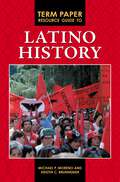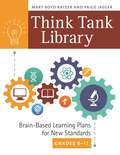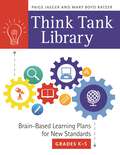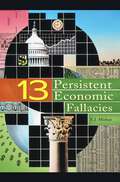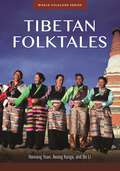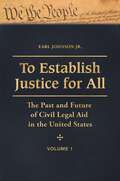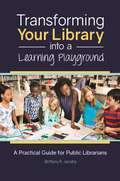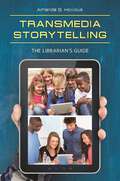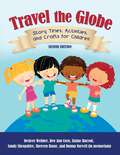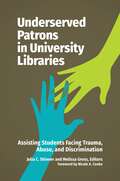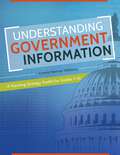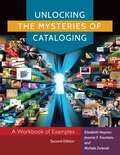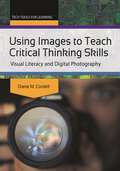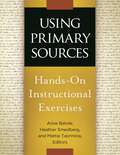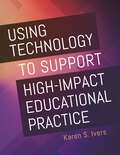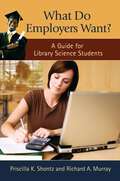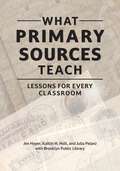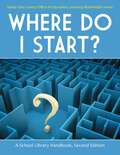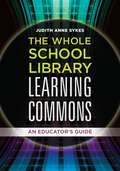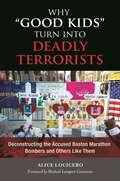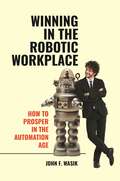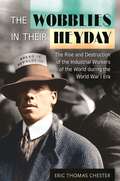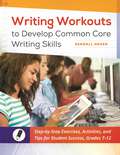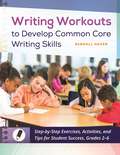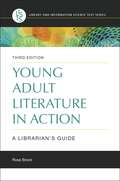- Table View
- List View
Term Paper Resource Guide to Latino History (Term Paper Resource Guides)
by Michael P. Moreno Kristin C. BrunnemerThis resource guide to 100 key events in Latino history provides students, librarians, and scholars with hundreds of original and compelling term paper ideas and the key print and electronic sources needed for research.Latinos are the largest, fastest growing minority group in the United States, and the ways they have positively impacted our nation are significant and undeniable. This book examines the contributions of Latinos to U.S. history, providing hundreds of possible topics for term papers and research projects along with primary, secondary, web, and multimedia sources of topical information. Subjects such as the Treaty of Guadalupe Hidalgo (1848); the Bracero Program (1942); the United Farm Workers of America Is Formed (1962); and The Great American Boycott ("A Day Without Immigrants") of 2006 are just a few samples of the topics included.Each historical event is described briefly, followed by direction toward specific research and writing topics for the student-historian. At least two alternative term paper suggestions complement these ideas, allowing creative, original approaches to historical inquires.
Think Tank Library: Brain-Based Learning Plans for New Standards, Grades 6–12
by Mary Boyd Ratzer Paige JaegerTransform your library into a "think tank" by helping teachers create an active learning environment in which students question, investigate, synthesize, conclude, and present information based on Common Core standards.The rigors of today's mandated academic standards can repurpose your library's role as a steward of the Common Core State Standards (CCSS) at your school. Created for teachers of grades 6 through 12, this guide will help you help present exciting, field-tested lessons that address developmental steps and individual differences in key competencies in the CCSS. Authors and educators Mary Ratzer and Paige Jaeger illustrate how brain-based learning helps students become deep, critical thinkers, and provide the lesson plans to coax the best thinking out of each child.This tool book presents strategies to help learners progress from novice to expert thinker; challenge students with questions that lead to inquiry; incorporate "rigor" into lessons; and use model lesson plans to change instruction. Beginning chapters introduce the basics of instruction and provide ideas for expert cognitive growth of the brain. Sample lessons are aligned with key curriculum areas, including science, social studies, music, art, and physical education.
Think Tank Library: Brain-Based Learning Plans for New Standards, Grades K–5
by Paige Jaeger Mary Boyd RatzerTransform your library into a "think tank" by helping teachers create an active learning environment in which students question, investigate, synthesize, conclude, and present information based on Common Core standards.The rigors of today's mandated academic standards can repurpose your library's role as a steward of the Common Core State Standards (CCSS) at your school. This guide will help you help teachers present exciting, field-tested lessons for elementary grades K through 5, addressing developmental steps and individual differences in key competencies in the CCSS. Authors and educators Mary Ratzer and Paige Jaeger illustrate how brain-based learning helps students become deep, critical thinkers and provide the lesson plans to coax the best thinking out of each child.This tool book presents strategies to help learners progress from novice to expert thinker; challenge younger students with questions that lead to inquiry; incorporate "rigor" into lessons; and use model lesson plans to change instruction. Beginning chapters introduce the basics of instruction and provide ideas for expert cognitive growth of the brain. Sample lessons are aligned with key curriculum areas, including science, social studies, music, art, and physical education.
Thirteen Persistent Economic Fallacies
by E. MishanE. J. Mishan, an iconoclastic economist who has taught at such schools as the London School of Economics and the New School for Social Research, is in this volume a provocateur, smashing staunchly held beliefs of the right (free trade and common markets are good for the economy), and the left (local jobs are always lost when factories close down, pay disparity between men and women signifies discrimination). He also pokes holes in the accepted wisdom held by all, arguing for example that economic growth does not necessarily improve lives. Those who believe the fallacies Mishan exposes to the light of reason in this book are, however, neither ignorant nor careless. The fallacies are all plausible, and intelligent people can be forgiven for believing them. Mishan simply wants readers to see these thirteen popular, persistent fallacies for what they are: Humbug.Mishan's scintillating text is apolitical. In arguing that immigration does not benefit a country's economy, for example, he is not arguing in favor of restricting immigration. Rather, his goal is to test the assumptions behind the dearly held positions of both the left and the right or to expose what he calls the breathtaking fatuity that counts as wisdom these days. Mishan wants to interject common sense and logic into today's debates over the economy and, especially, the political arguments that translate into legislation that has a negative impact on people. Mishan's ideas breathe new life into debates gone stale by ideology. As he notes, the fallacies in this volume travel in the highest circles, from debates in Congress to the pages of the Wall Street Journal, Time, and The Economist. Most are things everybody knows. He hopes, therefore, to expose the concerned citizen to the shock-treatment of discovering that much of what passes for conventional economic wisdom is in fact fallacious. As the Economist pointed out in its glowing review of the first edition of this book, Dr. Mishan has written the perfect book for anyone wishing to start the study of economics.
Tibetan Folktales (World Folklore Series)
by Haiwang Yuan Awang Kunga Bo LiThis collection of folktales provides readers with an extensive overview of the breadth of Tibetan culture, revealing the character of the region and its people as well as their traditional customs and values.Most Westerners are unlikely to travel to the mountainous region of East Asia and experience the Tibetan people and their culture directly. This book provides a way to experience and learn about this remote nation through carefully selected Tibetan folktales that provide readers with a unique glimpse into Tibet's culture, its people, and the land itself through the window of folklore. Providing a unique resource that can serve both as a storytime aid for educators who work with primary school students and a valuable reference for Eastern folklorists, Tibetan Folktales contains more than 30 traditional Tibetan stories that give readers a taste of the land, people, culture, history, religion, and psyche of this remote country. The tales are gathered from contemporary Tibetan storytellers and translated from written sources to represent the rich oral and written literary tradition of Tibet's culture. In addition, the book supplies tutorials for Tibetan crafts and games, a sample of recipes, and photographs and illustrations that create a multidimensional experience of Tibetan culture.
To Establish Justice for All [3 volumes]: The Past and Future of Civil Legal Aid in the United States [3 volumes]
by Earl JohnsonFor over a century, many have struggled to turn the Constitution's prime goal "to establish Justice" into reality for Americans who cannot afford lawyers through civil legal aid. This book explains how and why.American statesman Sargent Shriver called the Legal Services Program the "most important" of all the War on Poverty programs he started; American Bar Association president Edward Kuhn said its creation was the most important development in the history of the legal profession. Earl Johnson Jr., a former director of the War on Poverty's Legal Services Program, provides a vivid account of the entire history of civil legal aid from its inception in 1876 to the current day. The first to capture the full story of the dramatic, ongoing struggle to bring equal justice to those unable to afford a lawyer, this monumental three-volume work covers the personalities and events leading to a national legal aid movement—and decades later, the federal government's entry into the field, and its creation of a unique institution, an independent Legal Services Corporation, to run the program. The narrative also covers the landmark court victories the attorneys won and the political controversies those cases generated, along with the heated congressional battles over the shape and survival of the Legal Services Corporation. In the final chapters, the author assesses the current state of civil legal aid and its future prospects in the United States.
Transforming Your Library into a Learning Playground: A Practical Guide for Public Librarians
by Brittany R. JacobsPublic libraries must offer relevant, exciting, and stimulating learning centers that appeal to kids. This book is a step-by-step guide for creating affordable and effective educational programs for children and youth by focusing on one simple concept: play.With the standards of education rising every year and current technology making all types of information widely available to anyone with an Internet connection, libraries need to stay relevant by constantly evolving. One important way to strengthen a public library's identity as an irreplaceable resource is to make it an exciting and stimulating learning center that appeals to children and youth. This book demonstrates how to transform the informal setting of a public library into a place where "play" in the guise of game-based learning becomes a natural and exciting process for children and young students. It also shows readers how to incorporate existing programs such as the makerspace, storytime, and book clubs to play to their strengths; more effectively utilize the tools and resources they have; and transform their libraries.The first two chapters explain why learning through play and exploration isn't only for early childhood development, identifies the key differences between free play and structured play, and addresses why libraries are the perfect setting for learning. Next, the author draws on her experience in children's librarianship and as a children's book author to describe methods to listen to (and understand) children, manage organized chaos, and gain the children's trust. Additional chapters explain how to write weekly or daily lesson plans, how to brainstorm supporting activities to reinforce concepts being taught, and how to infuse STEM and literacy objectives into daily lessons. The book closes with suggestions on marketing and promotion, ways to support the classroom, and strategies that will "keep 'em coming back" and build an enthusiastic customer base.
Transmedia Storytelling: The Librarian's Guide
by Amanda S. HoviousThis practical and thorough guide offers clear explanations of what transmedia storytelling is and shows how it can be integrated into library programming that fosters multimodal literacy with K–12 learners.When fictional worlds are brought to life in multiple media—via books and comics or through films, animated shorts, television, audio recordings, and games—it is called "transmedia storytelling." Transmedia storytelling offers children's and teen librarians at public libraries, K–12 school librarians, and educators an effective method for bringing story to youth—a perfect fit for today's media-saturated environment. This book demonstrates how to create new pathways to the future of stories and storytelling.The book serves as a guide to integrating transmedia storytelling into library programs and services. It defines transmedia storytelling, identifies the key connections between it and 21st-century learning, discusses the role of librarians and libraries in supporting and promoting transmedia storytelling, and provides concrete examples of transmedia programs. The suggested programs—ranging from transmedia storytimes for early literacy learners to maker programs for young adults—can be implemented with different levels of technology capabilities and within numerous library settings. In addition, the book offers practical advice on technology planning for libraries that plan to incorporate transmedia storytelling.
Travel the Globe: Story Times, Activities, and Crafts for Children
by Desiree Webber Dee Ann Corn Elaine R. Harrod Sandy Shropshire Shereen Rasor Donna NorvellThis book assists the busy professional with ready-to-use materials to present entertaining, educational, and age-appropriate programs that introduce young learners to countries and cultures around the world.The result of a collaboration of children's librarians and educators with over 70 years' combined experience, Travel the Globe: Story Times, Activities, and Crafts for Children, Second Edition offers the busy librarian, teacher, or media specialist with ready-to-use resources that introduce children to countries and cultures around the world. It provides recommended books, stories, action rhymes, fingerplays, games, and activities that can be used to plan a series of programs or a single activity that are both entertaining and educational.The book is organized alphabetically by country, with simple, low-cost craft ideas included in each chapter. All crafts use low-cost supplies and are simple to prepare and execute. At least two craft projects are included in each chapter: one for preschoolers, with suggestions for additional simplification; and another designed for children in kindergarten through third grade. The wide variety of resources within makes this book a valuable investment, as it will be useful year after year with new presentations and activities.
Underserved Patrons in University Libraries: Assisting Students Facing Trauma, Abuse, and Discrimination
by Julia C. Skinner and Melissa GrossThis practical and research-based volume focuses on how libraries can meet the needs of underserved patrons in college and university libraries, with an emphasis on those facing trauma, abuse, and discrimination.While university libraries strive to meet the needs of all students, some groups have traditionally been overlooked. This volume engages with those underserved populations on college campuses, with an emphasis on those facing trauma, abuse, and discrimination. It brings a variety of authorial voices to discuss different aspects of that service and to share current research related to underserved populations in libraries. This combination supports research in LIS and beyond while offering concrete ways for service providers to make a difference in the lives of their patrons.Editors Skinner and Gross have both conducted extensive research in ethically meeting patron needs. They and their contributors are keenly aware of the complex and interwoven considerations that inform such service, such as patron desire for confidentiality accompanied by an urgent need for assistance. This volume is committed to sharing diverse voices in the field and to exploring the interrelationship between theoretical findings and practical applications—all in the service of underserved patrons.
Understanding Government Information: A Teaching Strategy Toolkit for Grades 7–12
by Connie Hamner WilliamsThis book demonstrates how government information can be used to engage students through inquiry and project-based activities, thereby providing opportunities for creative investigation and discovery.Many government agencies and institutions provide educators with curricula, lesson plans, data, and direction—all of it free. But to access this largely hidden world of government information, one needs an understanding of how this government information is organized and knowledge about how to best utilize the finding aids, databases, and other search mechanisms to help guide effective research. This guidebook shows you how to locate high-quality, effective lesson plans developed by the nation's best educators, access reliable government data, and find curated lists of free government sources that are theme-based and reference national standards in social studies and health.Understanding Government Information: A Teaching Strategy Toolkit for Grades 7–12 is ideal for middle school and high school librarians and teachers in all subject areas, public youth services librarians, as well as parents teaching their students in home school based programs. You'll learn how to access expert-developed lesson plans, documents, images, and other primary sources along with suggested activities. The book also includes a teacher toolkit that details strategies for lessons and student activities that can be used across the curriculum.
Unlocking the Mysteries of Cataloging: A Workbook of Examples
by Elizabeth Haynes Joanna F. Fountain Michele ZwierskiIdeal for students and both beginning and practicing catalogers in public, school, and academic libraries, this updated workbook offers targeted, hands-on exercises that enhance understanding of description, classification, subject analysis, subject heading application, and MARC 21 subject analysis.Like the first edition, this updated workbook has a straightforward goal: to help expand and improve the effectiveness of library catalogs. It is designed to supplement existing textbooks by providing exercises in AACR2r and RDA description, classification, subject analysis, and MARC protocols. Particular attention is given to problems that may arise when cataloging books as well as multimedia combinations, 3-D items, toys, natural objects, maps, printed and performed music, bilingual materials, and electronic files. Through the exercises, you will better understand the overall process of cataloging an item and making a record, the application of RDA in producing records, the steps for cataloging new media, and the differences in records using RDA or AACR2r.To enhance the exercises, the workbook incorporates photographs of real materials and offers questions for consideration. There is also a companion website with enlargeable color graphics. The site provides complete answer records and additional indexes for instructors to use in selecting examples for specific elements in the record. For students, new or advanced, selected MARC answer records are included, as are special lists, forms, and indexes leading to the tools any cataloger will need.Student ResourcesExercisesThe images from the exercises in the book are included in this section in a larger format for closer examination. ExercisesMARC TemplateFor use in drafting cataloging records for all types of elements. MARC TemplateInstructor's ResourcesMARC and RDA answer records are provided to instructors upon request. Please contact CustomerService@abc-clio.com for more information.
Using Images to Teach Critical Thinking Skills: Visual Literacy and Digital Photography (Tech Tools for Learning)
by Diane M. CordellLearn how to teach visual literacy through photography—an easy way for you to combine student interest with resources at hand to enhance a key learning skill.Research indicates that 75 to 90 percent of classroom learning occurs through the visual system, making visual literacy a key component of information literacy and of critical thinking—a requirement throughout the Common Core standards. It's no surprise then that visual literacy is increasingly recognized as a competency that should be part of every student's skill set. Fortunately, this critical skill can be incorporated into existing curriculum, and this book shows you how to do just that. Written for K–12 classroom teachers and librarians, this all-you-need-to-know volume discusses the importance of visual literacy in education and examines how it helps address current learning standards. The book shows you how to use photography and digital images to cultivate critical thinking, inquiry, and information literacy; provides examples of the use of photographic images in the classroom and in "real life"; and addresses how students can be ethical practitioners in a digital world. In addition, the book includes sample lessons you can easily implement, regardless of your level of technical and photographic expertise. A resource list of photo editing, curation, and museum sites is included.
Using Primary Sources: Hands-On Instructional Exercises
by Anne BahdeAn ideal resource for cultural heritage professionals who teach with original materials, this book provides fresh, adaptable, and easy-to-implement primary source literacy exercises to improve their teaching and engage their students.Special collections librarians and archivists in academic settings are often confronted with the challenge of teaching classes outside their personal area of expertise, with very little notice or guidance—as the authors of this book can attest. Using Primary Sources: Hands-On Instructional Exercises features 30 adaptable, hands-on exercises that special collections librarians, archivists, museum professionals, and teaching faculty can use in a multitude of instructional situations with K–12, undergraduate, graduate, and library school students.The exercises teach lessons in both archival intelligence—such as building skills in using finding aids and locating primary sources—and artifactual literacy, such as building skills in interpretation and analysis of primary sources. Each exercise includes sections for audience, subject area, and materials used so that instructors can find customizable, easy-to-follow "recipes" to use regardless of personal experience and expertise. In addition, this consultable reference resource includes a bibliography of readings related to instruction in special collections, archives, and museum environments.
Using Technology to Support High-Impact Educational Practice
by Karen S. IversEmphasizing the importance of preparing students for the global workforce, this title explains how to teach using the latest educational technology.As technology becomes more advanced and accessible, it gives rise to new delivery methods of instruction and learning. High Impact Educational Practices including collaboration, diversity, global learning, service- and project-based learning, and research and writing, can be used to strengthen students' readiness for the demands of the 21st-century global community and workforce.This book helps current and future K–12 educators to better understand high impact educational practices and why they are important. It provides educators with ideas of how to use technology to support high impact educational practices in their classrooms and helps them to create just, equitable, and inclusive learning environments that support 21st-century learning.
What Do Employers Want?: A Guide for Library Science Students
by Priscilla K. Shontz Richard A. MurrayA candid, comprehensive, and insightful explanation of what library school students need to do in order to maximize their chances of getting a professional position immediately after graduation.While library schools provide graduates with a solid understanding of library science concepts, many diploma holders have no clear plan for finding a desirable job with their knowledge The information in What Do Employers Want? A Guide for Library Science Students will be extremely valuable for students currently in Masters of Library Science program as well as recent recipients of MLS degrees, regardless of what kind of work environment they wish to work in.The book guides readers through the process of planning a job search step-by-step. Divided into two major sections—the student experience and the job search—the authors provide critical advice derived from their combined 30 years of real-world, in-the-field experience. Specific topics include choosing classes, gaining practical experience while in school, establishing a professional image, gaining skills that make applicants more marketable, writing effective resumes and cover letters, interviewing, and negotiating a job offer.
What Primary Sources Teach: Lessons for Every Classroom
by Jen Hoyer Kaitlin H. Holt Julia Pelaez Brooklyn Public LibraryBuild confidence in delivering primary source–based instruction with easily adaptable, skill-based lessons that can be used in a variety of learning environments. Each lesson offers suggestions for differentiating instruction with diverse audiences, worksheets, and activity templates.What Primary Sources Teach provides practical and transferable lesson plans focused on skill-based instruction, including step-by-step instructions; ideas for differentiation; corresponding teaching tools, such as worksheets and activity templates; and suggestions for assessment. This book includes resources that are intuitive to classroom teachers and easily adoptable by librarians and informal educators tasked with translating their current primary source-based instruction to a K–12 environment.This book celebrates the role of primary source education and provides a wide range of educators with a shared language for articulating the relevance of teaching with primary sources. The reader will build confidence delivering primary source-based instruction as they work their way through the lesson plans, tools, and resources offered in this book. Eventually, they will feel comfortable designing lesson plans of their own for primary source–based instruction.
Where Do I Start?: A School Library Handbook
by Santa Clara County Office of EducationIf you're new to running a library or looking for a refresher, this book can serve as your first reference source for school library operation, providing overview information on a wealth of topics, lists of resources for more in-depth information, and coverage of current topics such as Web 2.0, fundraising, digital booktalks, and cybersafety.With the extreme budget cuts most school libraries are facing, professional development resources for library support staff that improve library management efficiency are in great demand. This popular handbook provides an overview of many topics related to school libraries, collecting a vast amount of information together in one volume with an extensive index and selected additional resources.Written in an accessible style, it provides a quick reference and overview information for the operation of school libraries that both experienced and new library staff will find useful. Designed to be read both cover-to-cover and utilized as a ready reference, the second edition of Where Do I Start?: A School Library Handbook has updated subject material that includes coverage of Web 2.0 applications, library web pages, reading books to students, digital storytelling, future trends in library automation, and more.
The Whole School Library Learning Commons: An Educator's Guide
by Judith Anne SykesIntroduce your teachers, librarians, and administrators to the roles and responsibilities of educators in advocating a whole school library learning commons using this step-by-step guide for creating shared learning space in your school.It is no surprise that technology has shifted the way we educate—bearing on how, what, and where we learn. This guide lays the framework for helping turn your school library into a whole school library learning commons (WSLLC)—a space where traditional academics merge with the latest technologies to engage learners in a way never before realized. Author Judith Anne Sykes contends that since the WSLLC philosophy allows staff and students to co-create knowledge in a shared space, it is more effective than the traditional approach. Sykes addresses the differences between a school library and a WSLLC, provides reasons to champion its creation in your institution, and discusses how to use mentoring as a means to sustain its survival. The book explores the roles and responsibilities of educators in developing WSLLC goals and presents strategies for using typical assessment tools—including standardized tests, report cards, and anecdotal assessments—to help support its philosophy.
Why "Good Kids" Turn into Deadly Terrorists: Deconstructing the Accused Boston Marathon Bombers and Others Like Them
by Alice LoCiceroUsing psychological theory and the author's direct experience working with at-risk youth, this book answers the questions on the minds of anyone shocked and appalled by the events of the Boston Marathon bombings.The shock of the 2013 Boston Marathon bombings was soon followed by a revelation initially disturbing and mystifying: two apparently unremarkable brothers—one a teenager, the other a young adult; both well-liked immigrants and longtime U.S. residents—had allegedly triggered the bombs. Why were these two seemingly "normal" individuals driven to commit such acts of coldblooded violence? This book examines not only the lives, motivations, and key influences of these infamous brothers, but those of other young, unexpected terrorists worldwide, comparing factors that contributed to their decisions to become terrorists and identifying methods used to recruit them into that deadly fold. The chapters teach readers warning signs that youths are being drawn in to terrorism and serve to spur meaningful conversations among citizens, politicians, and policymakers about what we can do to prevent such recruitment of youths and young adults, including other U.S. residents who might consider emulating the Tsarnaev brothers. The book also addresses larger, related questions, such as whether humans are naturally violent, who benefits when young individuals engage in terrorism, and why minors are recruited to become killers.
Winning in the Robotic Workplace: How to Prosper in the Automation Age
by John F. WasikThis book will examine the history of robotics and explicate what massive automation means for the present and future of labor in all its forms, from mills and factories to the white-collars offices of suburbia and more.While warnings of a robot world-takeover could seem dramatic, the truth is more mundane—robots have come to take our jobs. Winning in the Robotic Workplace: How to Prosper in the Automation Age will teach you the skills needed to reprogram the way you work in anticipation of this technological shift. Author John F. Wasik believes learning to thrive in the automation age can in fact humanize the workplace once again. In Winning in the Robotic Workplace: How to Prosper in the Automation Age, you will learn to emphasize the conceptualization and pursuit of creative ideas, a practice that most robots are unequipped to perform in a meaningful way. You will learn that the successful integration of automated elements with humans is the most effective business model moving forward, and that an eagerness to collaborate demonstrates a will to succeed.
The Wobblies in Their Heyday: The Rise and Destruction of the Industrial Workers of the World during the World War I Era
by Eric Thomas ChesterDuring World War I, the Industrial Workers of the World (IWW) rose to prominence as an effective, militant union and then was destroyed by a devastating campaign of repression launched by the federal government. This book documents the rise and fall of this important industrial labor organization.The Industrial Workers of the World—or "Wobblies," as they were known—included legendary figures from U.S. labor history. Joe Hill, "Big Bill" Haywood, and Elizabeth Gurley Flynn have become a part of American popular folklore. In this book, author Eric T. Chester shows just how dynamic a force the IWW was during its heyday during World War I, and how determined the federal government was to crush this union—a campaign of repression that remains unique in U.S. history. This work utilizes a wide array of archival sources, many of them never used before, thereby giving readers a clearer view and better understanding of what actually happened.The book leads with an examination of the three key events in the history of the IWW: the Wheatfield, CA, confrontation; the Bisbee, AZ, deportation; and the strike of copper miners in Butte, MT. The second part of the book deconstructs the IWW's responses to World War I, the coordinated attack by the federal government upon the union, and how the union unraveled under this attack.
Writing Workouts to Develop Common Core Writing Skills: Step-by-Step Exercises, Activities, and Tips for Student Success, Grades 7–12
by Kendall HavenThis book is a "best of" collection of tips and exercises to help nurture young writers and strengthen core skills. Since each activity has been tried and tested in thousands of classrooms, you'll find successful methods for turning even the most reluctant students into effective, powerful writers.Writing proficiency is more important than ever, especially with the demands of standardized testing and the rigors of new standards impacting our schools. This classroom-tested manual, created from a combination of the author's extensive in-class experience and acclaimed research in neural science and developmental biology, addresses all facets of writing competency. The content links to common core curriculum elements in state language arts standards for every state.Written by experienced educator and author Kendall Haven, the work features 13 innovative writing tips and 30 engaging activities for helping students become better writers. The first part of the book covers writing hints and techniques, while the second half contains core content activities for coaxing the best writing out of your students. A short introductory section lays out the five steps of effective student writing. Lastly, the text reveals how teachers—even those from non-literary backgrounds—can successfully teach and grade writing.
Writing Workouts to Develop Common Core Writing Skills: Step-by-Step Exercises, Activities, and Tips for Student Success, Grades 2–6
by Kendall HavenThis book is a "best of" collection of tips and exercises to help nurture young writers and strengthen core skills. Since each activity has been tried and tested in thousands of classrooms, you'll find successful methods for turning even the most reluctant students into effective, powerful writers.Writing proficiency is more important than ever, especially with the demands of standardized testing and the rigors of new standards impacting our schools. This classroom-tested manual, created from a combination of the author's extensive in-class experience and acclaimed research in neural science and developmental biology, addresses all facets of writing competency. The content links to common core curriculum elements in state language arts standards for every state.Written by experienced educator and author Kendall Haven, the work features 13 innovative writing tips and 30 engaging activities for helping students become better writers. The first part of the book covers writing hints and techniques, while the second half contains core content activities for coaxing the best writing out of your students. A short introductory section lays out the five steps of effective student writing. Lastly, the text reveals how teachers—even those from non-literary backgrounds—can successfully teach and grade writing.
Young Adult Literature in Action: A Librarian's Guide (Library and Information Science Text Series)
by Rose BrockTaking a genre approach, this overview of young adult literature shows new librarians and library science students the criteria to use for selecting quality books, including recommended titles.This third edition of Young Adult Literature in Action draws on the success of the previous two editions authored by Rosemary Chance, updating and expanding on them to meet the needs of today's librarians and library science students. It includes a new focus on diverse books, LGBTQ+ selections, the role of book formats, and the relevance of librarians serving teen populations and is an ideal resource for teaching young adult literature courses.Organized by major genre divisions, this easy-to-use book includes new information on timely topics such as audio and e-books, accessible books, and graphic novels. Each chapter includes revised and updated information on collaborative activities, featured books, special topics and programs, selected awards and celebrations, historical connections, recommended resources, issues for discussion, author comments, and assignment suggestions. Further updates include citations of exemplary young adult books and award winners, references, websites, and a bibliography.
